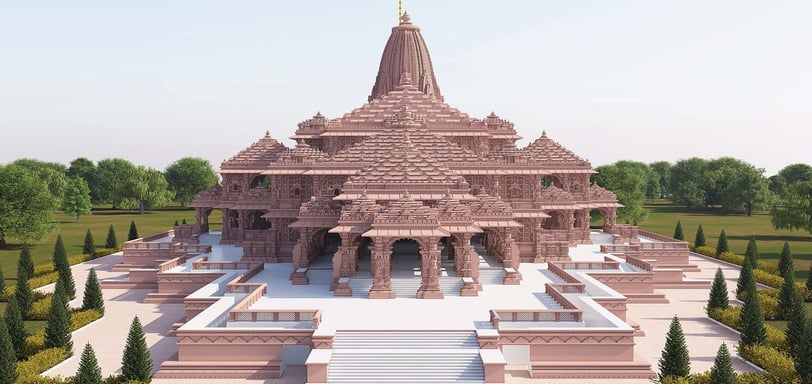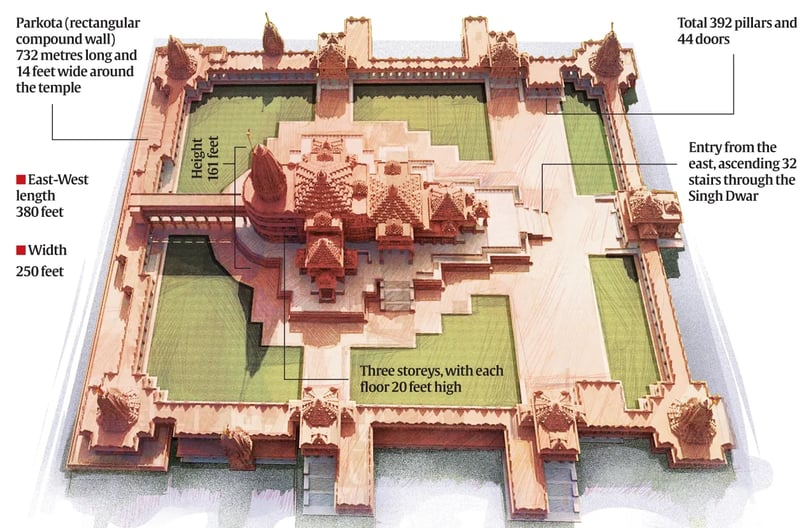Ram Mandir Janmabhumi might need more Oxygen Support
Countdown to history! Join the anticipation for the grand inauguration of Ayodhya's Ram Mandir on January 24, 2024, with insights into the temple's architecture, historical facts, and healthcare preparations.


The Shri Ram Janmabhoomi Temple in Ayodhya is going to be opened on January 22, with Prime Minister Narendra Modi and other important people there. After a special ceremony for Ram Lalla in the main part of the temple, it will be open for everyone to visit starting January 24.
The temple is not just a regular building – it's like a special treasure filled with faith and traditions that have been a part of India for a very long time. The temple has amazing carvings that tell the story of India's history, making it a really special place. If you're interested in history and tradition, this is a must-visit spot!
Important Facts about Ram Mandir
Chandrakant Sompura, and his two sons – Nikhil Sompura and Ashish Sompura are the chief architects.
The design advisors of Ram Mandir are IIT Guwahati, IIT Chennai, IIT Bombay, NIT Surat, Central Building Research Institute Roorkee, National Geo Research Institute Hyderabad, and the National Institute of Rock Mechanics.
The Construction company of the Mandir is Larsen and Toubro (L&T).
Overall project is manage by Tata Consulting Engineers Limited ( TCEL)
The total area of the Mandir is 70 Acre (70% green Area)
The Temple area is 2.77 Acre
The main materials used in building the Ram Mandir are:
Bansi Paharpur Pink Sandstone: This special sandstone from Rajasthan's Bharatpur district was used for the main structure of the temple.
Granite Stones: These were used for the plinths, providing a strong and durable foundation.
White Makrana and Colored Marbles: These marbles were used for intricate inlay work, adding a touch of beauty and artistry to the temple.
Teakwood: Selected for its strength and elegance, teakwood was used in crafting the doors of the temple.
Special Bricks - Ram Shilas: Bricks with "Shri Ram" inscribed on them, known as Ram Shilas, were used. These bricks not only contribute to the construction but also carry symbolism, connecting with the stones used in the construction of Ram Setu.
Other Materials: The construction also involved the use of Shaligram Rock, Copper Plates, Gold, and Ashtdhatu.
By combining these materials, the builders have created a structure that blends modern craftsmanship with ancient symbolism, making the Ram Mandir a unique and significant place.
The Main Temple Architecture:
The main temple follows the Nagara Style of architecture. Originally planned in 1988 by the Sompura family from Ahmedabad, the design underwent modifications in 2020 to align with Vastu Shastra and Shilpa Shastra, showcasing a deliberate effort to combine aesthetic beauty with ancient wisdom.
The Sompura family, known for their temple craftsmanship legacy and contributions to renowned temples like Somnath, brings a sense of continuity and historical artistry to the architectural design of the Ram Mandir.
This three-story temple is designed to take devotees through different stages of Lord Rama’s divine journey. The ground floor tells the story of Lord Rama's birth and childhood, while the first floor is modeled after Lord Rama’s Darbaar. The temple features five Mandaps (Halls) – Nritya Mandap, Rang Mandap, Sabha Mandap, Prarthna, and Kirtan Mandaps – creating a sacred space for various rituals and devotional experiences.
Ram Mandir opening ceremony
The highly anticipated Ayodhya Ram Mandir, a cutting-edge temple in India, is set to be inaugurated by Prime Minister Modi on January 24, 2024. Recognized as one of India's holiest sites and the birthplace of Shri Ram, Ayodhya holds special significance.
The Ayodhya Ram Mandir is expected to be completed around February 24, 2024. Once the official Opening Date is announced, individuals can register for tickets to experience the Ayodhya Ram Mandir Darshan in 2024.
Scheduled for inauguration on January 24, 2024, Prime Minister Narendra Modi will officiate the opening ceremony of the Ram Mandir, marking a significant and historic event.
Ayodhya Gears Up for Ram Temple Inauguration with Kumbh-like Healthcare Arrangements
In preparation for the grand inauguration and consecration ceremony of the Ram Temple in Ayodhya, the state government is taking proactive measures to ensure robust healthcare services akin to those witnessed during the Kumbh Mela. Deputy Chief Minister in a recent review meeting with senior health officials, has directed the health department to implement necessary arrangements.
The comprehensive healthcare plan includes:
Increased Hospital Beds: The state plans to augment healthcare infrastructure by adding beds in hospitals to accommodate the expected influx of devotees.
·Additional Medical Staff: Ensuring sufficient medical personnel to manage the increased demand for healthcare services during the significant event.
Control Rooms: Setting up dedicated control rooms to efficiently coordinate emergency responses and medical assistance.
Blood Banks and Ambulances: Adequate provision of blood banks and ambulances to address any medical emergencies promptly.
Food and Water Supply: Special emphasis on ensuring a steady supply of quality food and water for the well-being of devotees.
Deputy Chief Minister underscored the importance of advanced preparations to guarantee a seamless and health-focused experience for attendees during this momentous occasion.
The necessity of oxygen support
In a large-scale occasions like Ram Mandir Inauguration with a significant gathering of people, the need for oxygen cylinders becomes crucial due to several reasons. Firstly, in densely populated events, the risk of medical emergencies, such as cardiac issues or respiratory distress, increases. Having oxygen cylinders readily available ensures prompt and life-saving intervention in case of such emergencies.
Secondly, in crowded gatherings, there may be instances of heat-related illnesses or situations where individuals experience difficulty breathing due to the confined space. Oxygen cylinders become a vital resource in providing immediate relief and stabilizing individuals facing respiratory challenges.
Moreover, during major events, there is often the potential for accidents or unforeseen circumstances that may lead to injuries requiring immediate medical attention. Oxygen support can be essential in stabilizing individuals until more comprehensive medical assistance can be provided.
Modern Facilities/Amenities in Ram Temple Premises
Multipurpose Distribution and Operations Room
Bank/ATM
Essential Public Utilities (Toilets, Bathroom, Washroom & More)
Emergency Medical Facilities
Ramps/Lifts for Senior Citizens
Solar Energy Panels and Power Back-Ups
Pilgrim facility center
Pilgrim/Visitor Management System
Conclusion
In conclusion, the opening of the Shri Ram Janmabhoomi Temple in Ayodhya represents a harmonious blend of tradition and modernity. The meticulous craftsmanship, diverse materials, and architectural design tell the story of Lord Rama, captivating devotees at every stage of his divine journey. As Ayodhya gears up for the grand inauguration, the state's proactive healthcare measures, reminiscent of the Kumbh Mela, underscore the commitment to devotee well-being. Modern amenities within the temple premises further enhance the visitor experience. This momentous occasion not only marks the establishment of a sacred place but also invites everyone to connect with India's rich cultural heritage.


